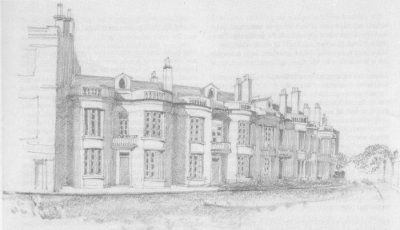Development Control - Trust Annual Report 1991
This year has seen major changes to the centre of Winchester. The Brooks Development has now been completed (though many of its units still await occupants) and the flow of traffic to St Georges Street has been re-routed from the southern end of Middle Brook Street along a new extension of Friarsgate to Upper Brook Street. The City also now has the ultimate tourist attraction: a McDonalds quick food restaurant!
The Trust has been involved - with varying degrees of success - with both ventures. It supported the City at the appeal against its refusal to allow a change of use from residential to retail for the top floor of the Brooks Development, because the residential use was an important component of the original scheme: the appeal was however allowed by the Inspector representing the Department of the Environment. The Trust also agreed with the opinion of the City's Conservation Officer that the shopfront and signs proposed by McDonalds were totally inappropriate for its sensitive location: in this instance the multi-national firm was willing to comply with local wishes, and should be congratulated for its response.
After what has seemed an interminable length of time under its shroud of tarpaulin and scaffolding, the sympathetic facade the shoe shop is a welcome addition to The Square. This ancient Listed Building has been restored at considerable cost, as have two other important Listed Buildings in the centre of Winchester. Both these have been restored leaving the original timbers fully exposed, so now it is possible to have one's eyes tested at 33 The Pentice or to eat a pizza at 1 City Bridge under the structural beauty of an arched mediaeval roof. Winchester should be very grateful indeed to the owners of these establishments for their contribution to the City's heritage.
Some items, after long campaigning by the Trust, have reached a successful conclusion while others are still in the no-man's-land of planning authority indecision. In the former category are the Buttercross, now visible in its restored glory, the roof and ballustrade at No. 4 Eastgate Street, which have been reinstated with a substantial contribution from the Trust, and the reappearance of a crisp new swan on the Black Swan Building - all concerned in each case have our gratitude. In the latter category are the Peninsula Barracks scheme (happily in response to our campaign with a reduced car-parking requirement) and the Westgate, where the long awaited repaving of the outer side of the gate still has to be done.

A drawing by Keith Leaman of the unique terrace in Eastgate Street where the Trust was instrumental in the completion of the restorations
started by the City Council. Grants to assist the owners of the last house to be restored were made by the Trust, the County &
City Councils, English Heritage and the Radley House Partnership
The Trust also participated in the deliberations over the future of the City Mill and the adjoining property at 3 and 5 Water Lane. The proposal by the YMCA to demolish the Water Lane houses was strongly opposed on the grounds that these modest cottages were closely linked, physically and historically, with both the mill and the rest of the buildings in Water Lane, and were also of great visual importance to the street scene. The National Trust (who own the City Mill) and the Hampshire Mills Group had a similar opinion, and we are happy to report that at present plans for this site are under review.
A major new building, the Record Office on the Carfax site, is now under construction. When the County Council put forward its proposals for the site the City not only considered that the Record Office should be elsewhere and that housing should be built on this location but was also critical of the design of the buildings. Following a presentation and careful consideration, the Trust reached different conclusions. Although worried about some details, and especially the landscaping, the Trust is not opposed to what will be a striking and controversial building on this corner but feels strongly that this should be the occasion for humanising Sussex Street with a central row of trees. The County Architect has said that he agrees, but can he make it happen? It is, incidentally, a highly undesirable quirk of the planning regulations that since this building is being erected by the County Council on its own site no planning permission is required.
Rapid and haphazard development has been a worrying aspect of recent years, so it is encouraging that the City Council is carrying out a study of the Upper/Middle Brook Street area so that there will be an integrated scheme for the area as a whole. The Trust has been involved since an early stage in these discussions, and has sent in a detailed response to the development brief, including comments from the Landscape Committee.
The concern about inappropriate shop fronts mentioned in last year's annual report is in the process of becoming action. The English Historic Towns Forum (an alliance of medium-sized historic towns of which Winchester City is a member) is discussing this with the large retail groups. On a local level the Trust, which has also become a member of the Forum, is endeavouring to make the smaller shops in the City aware of the problem by distribution the Forum's publication "Shop Fronts and Advertisements in Historic Towns". This worth while occupation could also be a lengthy one with the small number of people available to do the job, so if any members who feel strongly about this creeping degradation of the City's centre would care to help we would be very glad to hear from them.
